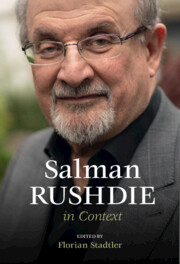Book contents
- Salman Rushdie in Context
- Salman Rushdie in Context
- Copyright page
- Dedication
- Contents
- Contributors
- Acknowledgements
- Introduction
- Part I Life
- Part II Literary and Creative Contexts
- Chapter 5 Salman Rushdie and the Urdu Tradition
- Chapter 6 Art-Historical Magic Realism and Rushdie’s Twenty-First-Century Politics
- Chapter 7 Salman Rushdie and Intertextuality
- Chapter 8 Salman Rushdie and Visual Art and Culture
- Chapter 9 Rushdie, Sound, and the Auditory Imagination
- Part III Historical and Cultural Contexts
- Part IV Critical Theoretical Contexts
- Part V Reception, Criticism, and Adaptation
- Works by Salman Rushdie
- Select Bibliography
- Index
Chapter 7 - Salman Rushdie and Intertextuality
from Part II - Literary and Creative Contexts
Published online by Cambridge University Press: 23 March 2023
- Salman Rushdie in Context
- Salman Rushdie in Context
- Copyright page
- Dedication
- Contents
- Contributors
- Acknowledgements
- Introduction
- Part I Life
- Part II Literary and Creative Contexts
- Chapter 5 Salman Rushdie and the Urdu Tradition
- Chapter 6 Art-Historical Magic Realism and Rushdie’s Twenty-First-Century Politics
- Chapter 7 Salman Rushdie and Intertextuality
- Chapter 8 Salman Rushdie and Visual Art and Culture
- Chapter 9 Rushdie, Sound, and the Auditory Imagination
- Part III Historical and Cultural Contexts
- Part IV Critical Theoretical Contexts
- Part V Reception, Criticism, and Adaptation
- Works by Salman Rushdie
- Select Bibliography
- Index
Summary
This chapter explores the multiple intertextual reference points that Salman Rushdie deploys in his work. While giving a sense of the range of influences in his work, an analysis of Rushdie’s use of intertextuality gives further insights into Rushdie’s artistic process but also the wider context of his own reading and cultural emersion in popular culture. Perhaps best captured in the idea of the ‘sea of stories’, Rushdie’s version of intertextuality finds links to his notions of hybridity encapsulated in both his characters and the production of his texts. This enables him to produce a wide network of transnational cultural reference points and to connect with multiple audience constituencies through a careful process of modulation of these. The chapter also explores the wider discursive notion of intertextuality as pioneered by poststructuralist theorists such as Roland Barthes and Julia Kristeva, in turn extending the work of Mikhail Bakhtin, which enables a contextualized analysis of the numerous vocalities located in his texts, exposing ideological power structures that Rushdie’s novels subvert and disrupt.
- Type
- Chapter
- Information
- Salman Rushdie in Context , pp. 94 - 104Publisher: Cambridge University PressPrint publication year: 2023

